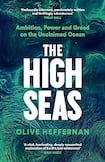
“We are astoundingly, sumptuously, radiantly ignorant of life beneath the seas ... ”
The words of North American-British author Bill Bryson come to mind on reading the opening chapters of Dr Olive Heffernan’s book. His observation in A Short History of Nearly Everything may be more than 20 years old, but in many ways it hasn’t dated at all.
As a marine biologist and extensively published science journalist, Dr Heffernan has documented many of the threats to an area covering two-thirds of our planet which we, as a species, left 400 million years ago. In the race for resources, deep-sea mining, industrial scale commercial fishing and plastic pollution top the naughty list.
One of the areas identified for deep-sea mining is the Clarion-Clipperton zone in the Pacific, where up to 90 per cent of species gathered are new to science. It is administered by the little-known International Seabed Authority, one of a number of bodies that, as she notes, give an illusion of some sort of regulation.
READ MORE
There are some two dozen ideas for drawing on the world’s oceans to mitigate greenhouse gas emissions, she tells us. These range from adding a trillion tonnes of crushed olivine rock to the ocean to burying giant kelp bales on the seafloor to marine cloud brightening, a type of solar geoengineering to cool the planet.
Yet there are some very simple alternatives. Marine animals are natural carbon harvesters, holding about 1.4 billion tonnes of the chemical element in their bodies. Restoring just eight species of whale to healthy population levels could store an additional 8.7 billion tonnes of living biomass in the sea, according to one analysis she cites.
There’s a lyrical quality to Dr Heffernan’s descriptions of the diversity of marine life, and an ease with which she alternates science with historical nuggets. She links up with a number of non-governmental organisations, but more of the voices of those who depend for their livelihoods on an often mismanaged sector would have provided valuable insight.
She offers positives such as new medical cures and a UN treaty of the oceans. Not surprisingly, she admits in the final chapter of her enthralling circumnavigation to a struggle to find reasons for hope.














